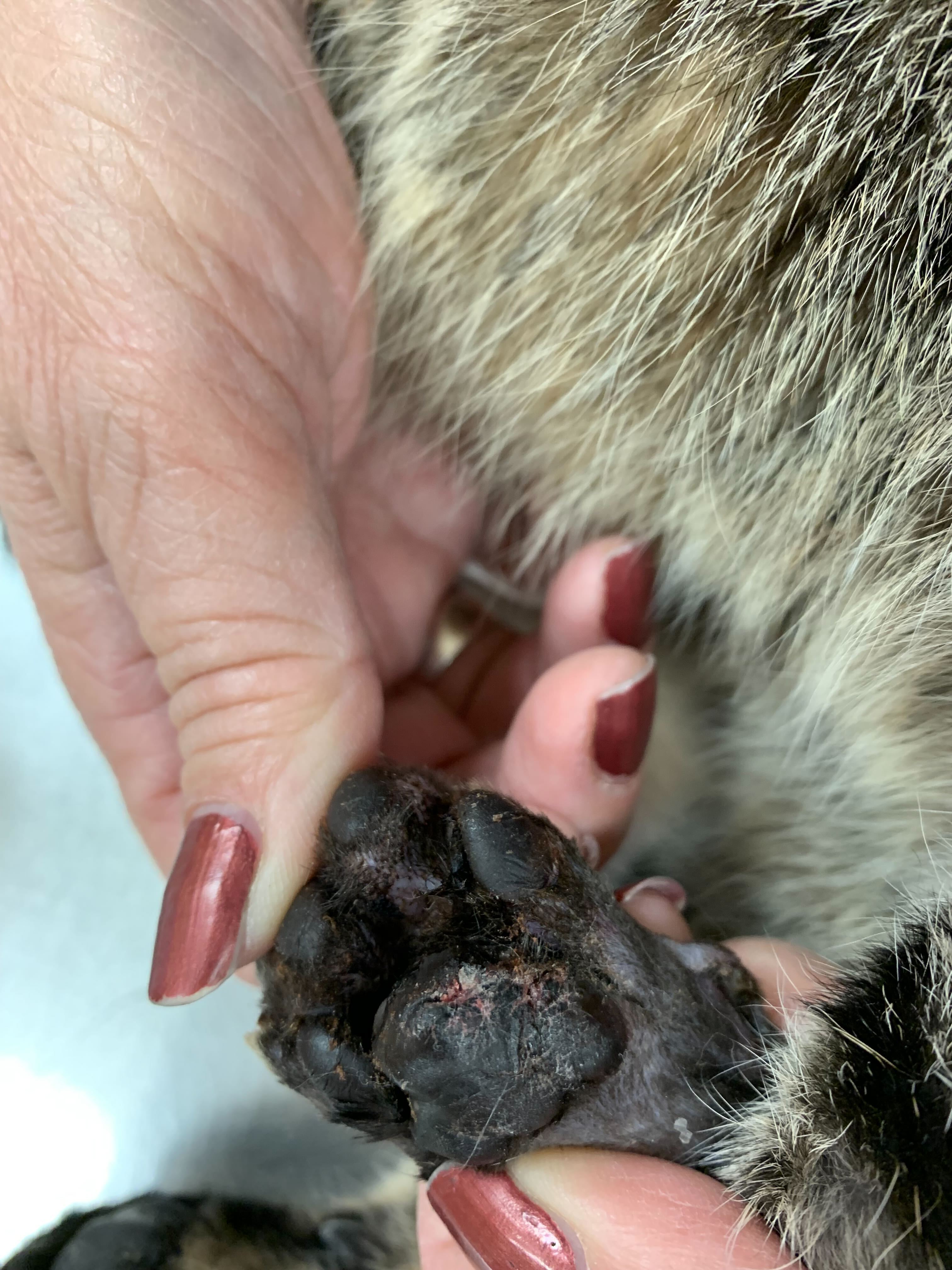Pillow Foot (Pododermatitis) in Cats
What Is Pillow Foot in Cats?
Feline plasma cell pododermatitis (PCP), also known as cat pillow foot, is a skin disease afflicting the paw pads in cats. The flesh of the paw pads is invaded by plasma cells, causing the pads to swell, resembling a pillow.
Plasma cells are a type of white blood cell activated in response to an infection or an inflammatory process. This infection or inflammation causes activation of the immune system’s plasma cells, then secretions against the infection or inflammatory process. The secretions build up in the paw pad, creating ballooning or swelling.
Health Tools
Not sure whether to see a vet?
Symptoms of Cat Pillow Foot
With PCP, the paw pads:
-
Are swollen or puffy, and smooth
-
Are affected on multiple feet
-
Initially have no ulcerations, but deep fissure lines (deep linear cracks) are present
-
Are deep pink or purple in color with multiple white striations
-
May indent in response to pressure, then become puffy when pressure is removed
-
Eventually may break open, resulting in limping or lameness
In some rare cases, the following symptoms can also be seen due to the increased numbers of plasma cells being generated in the body:
-
Swelling at the bridge of the nose
-
Upper respiratory tract infection
-
Inflammation of gum tissue and the lining of the mouth (stomatitis)
-
Glomerulonephritis (inflammation and dysfunction of the capillaries in the kidneys)
-
Eosinophilic granuloma (a mass or nodular lesion containing white blood cells called eosinophils, usually found on the back of the thighs, on the face, or in the mouth)
What Does Pillow Foot in Cats Look Like?


Causes of Cat Pillow Foot
The exact cause of pillow foot is unknown. It behaves like an autoimmune condition, so food allergies or environmental allergies could be a trigger. Contributing factors to the development of PCP are viral infections like feline leukemia virus (FeLV) and feline immunodeficiency virus (FIV).
Most cats with PCP are domestic short-haired cats, but PCP has been reported in non-short-haired breeds. Male cats are more frequently affected than female cats. Outdoor cats may be more likely to be affected than indoor cats due to their increased exposure to environmental factors.
How Veterinarians Diagnose Cat Pillow Foot
Based on the signs and symptoms listed above and a thorough history, PCP might be a working diagnosis (meaning the most likely cause of the symptoms, without a definite test to confirm). If other possibilities seem less likely, treatment may be started.
However, for a definite diagnosis, a biopsy of the paw pad lesions, while swollen, is needed. A biopsy determines if the lesions are from PCP, an eosinophilic granuloma, or a neoplasia, and if there is a bacterial and fungal component that will also require treatment. Cats with plasma cell pododermatitis may have elevated numbers of circulating plasma cells and high globulin levels. These changes support a diagnosis of PCP, but alone are not enough for a diagnosis.
Treatment of Cat Pillow Foot
Treatment is aimed at reducing swelling, pain, and discomfort and addressing any secondary bacterial or fungal infections.
Since plasma cells are activated from the immune system, focusing on the immune system to control symptoms is the first step in therapy. Initially, this may include anti-inflammatory oral glucocorticoids (like prednisolone), long-acting glucocorticoid injections (like methyl prednisolone), the antibiotic doxycycline, and the immunosuppressive cyclosporine. Improvement should be seen within one to two months with oral medications.
In extreme cases, surgery to remove the affected areas of the paw pads may be needed if they are severely ulcerated.
Recovery and Management of Cat Pillow Foot
The effects of PCP can be cleared, but reoccurrences can happen. Once a pet has developed PCP, it is possible to develop it again. Some cats may require medication for life to keep symptoms controlled.
In cases where surgical excision was performed, recovery time can be between two and four weeks. Recovery time is based on many factors: how immobile a cat is during the healing process (decreasing trauma to the surgical site), how extensive the damage from PCP was, and the ability to keep the paw pads clean.
When left untreated, the higher levels of plasma cells and globulins (a type of protein) in the can be fatal.
Cat Pillow Foot FAQs
Can pillow foot in cats be cured?
Pillow foot can be well controlled, but not cured entirely. It is possible that symptoms may reoccur. Most cats can achieve remission, with their paw pads returning to normal with appropriate therapy. However, some cats may require medication for life to keep PCP controlled.
Is pododermatitis in cats serious?
Yes, pillow foot can be serious. While not usually fatal, when left untreated, pillow foot affects other organs, especially the kidneys.
Is pillow foot painful for cats?
Because cats may limp on the affected foot and lick the affected paw, pillow foot may not always cause discomfort and pain from the paw’s swelling. However, secondary infections can cause pain.
Featured Image: iStock.com/hernan4429
Help us make PetMD better
Was this article helpful?
